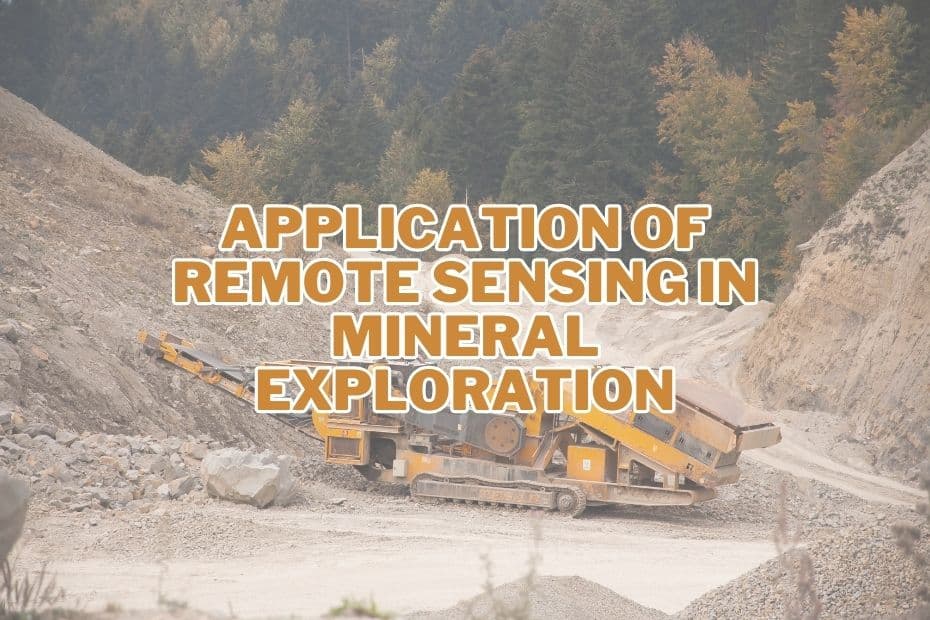Through advanced technologies and satellite imagery, we can now identify mineral-rich areas, map geological features, and monitor mining activities with unprecedented accuracy. In this article, we delve into the various application of remote sensing in mineral exploration, shedding light on how this technology has revolutionized the way we uncover and utilize Earth’s hidden treasures.
Remote sensing in mineral exploration involves using satellite or aerial imagery to identify surface features indicative of mineral deposits. This technology aids geologists in pinpointing promising sites for further investigation, reducing costs and increasing efficiency. Key applications include detecting surface anomalies, vegetation changes, and alteration minerals, making it a vital tool for modern mineral prospecting.
Application of Remote Sensing In Mineral Exploration
This technology has become indispensable in many fields, including mineral exploration. Here’s how remote sensing is applied in mineral exploration:
1. Mapping Surface Geology
One of the key application of remote sensing in mineral exploration is mapping surface geology. Satellite imagery allows us to identify geological formations, rock types, and structural features across vast areas. By analyzing these images, geologists can pinpoint potential mineral deposits and assess the overall geological context, streamlining the exploration process.
2. Identifying Mineral Spectral Signatures
Remote sensing enables the identification of mineral spectral signatures, which are unique patterns of light absorption and reflection exhibited by different minerals. By analyzing these signatures, geologists can infer the presence of specific minerals even from a distance. Hyperspectral imaging, a sophisticated remote sensing technique, plays a pivotal role in this process by detecting subtle variations in reflected light that correspond to different mineral compositions.
3. Vegetation Stress Analysis
Vegetation stress analysis is another application that aids mineral exploration. Minerals beneath the surface can affect the health of surrounding vegetation. Remote sensing techniques help monitor changes in vegetation health and identify areas where plants exhibit stress due to underlying mineral deposits. This indirect method provides valuable clues about the presence of hidden minerals.
4. Hydrothermal Alteration Detection
Hydrothermal alterations are changes in rock composition caused by hot fluids circulating in the Earth’s crust. These alterations often indicate the proximity of mineral deposits. Remote sensing technologies allow us to detect subtle changes in rock composition, facilitating the identification of hydrothermally altered areas and potential mineral reservoirs.
5. Topographic and Morphological Studies
Remote sensing assists in topographic and morphological studies of mineral-rich regions. High-resolution satellite images help create detailed elevation models, allowing geologists to analyze the terrain’s characteristics. This information aids in identifying areas conducive to mineral accumulation and provides insights into the geological history of the region.
6. Thermal Imaging
Thermal infrared remote sensing plays a crucial role in mineral exploration, especially for identifying minerals associated with temperature variations. Different minerals emit varying levels of thermal radiation, allowing us to identify their presence based on temperature differences. This technique is particularly effective in detecting minerals like sulfides and hydrocarbons.
7. Subsurface Exploration
Remote sensing goes beyond surface observations by enabling subsurface exploration. Ground-penetrating radar and other advanced techniques help create images of subsurface structures, revealing potential mineral deposits hidden beneath layers of soil and rock. This technology reduces the need for extensive drilling and excavation, making the exploration process more efficient and cost-effective.
8. Assessing Environmental Impact
Mineral exploration can have environmental consequences. Remote sensing allows us to monitor and assess these impacts by providing accurate data on land degradation, deforestation, and water pollution caused by mining activities. This information is vital for sustainable resource management and responsible mining practices.
9. Monitoring Mining Operations
Remote sensing continues to play a crucial role even after mineral deposits are identified. It enables real-time monitoring of mining operations, tracking activities such as excavation, transportation, and processing. This monitoring ensures compliance with regulations, minimizes environmental damage, and enhances operational efficiency.
10. Land Reclamation and Restoration Monitoring
After mining activities cease, land reclamation and restoration become priorities. Remote sensing aids in monitoring the progress of these efforts. By comparing current satellite images with historical data, we can assess the success of reforestation, erosion control, and ecosystem restoration projects.
11. Risk and Disaster Assessment
Mineral-rich areas are often prone to natural disasters such as landslides and earthquakes. Remote sensing helps assess these risks by monitoring changes in the landscape and identifying potential hazards. This information guides urban planning and infrastructure development to minimize the impact of disasters on mining communities.
Conclusion:
In conclusion, the application of remote sensing in mineral exploration has revolutionized the way we uncover, analyze, and utilize Earth’s mineral resources. From mapping surface geology to monitoring mining operations, this technology provides invaluable insights that enhance efficiency, sustainability, and environmental responsibility in the mining industry.
FAQs: Application of Remote Sensing In Mineral Exploration
Why is hyperspectral imaging crucial?
It captures information across a wide range of light spectra, providing detailed data that can be vital in detecting specific minerals.
Can remote sensing predict natural disasters?
By monitoring ground displacements, it can aid in predicting earthquakes and volcanic eruptions.
What is the primary tool for remote sensing in mineral exploration?
Satellites and aircraft equipped with advanced sensors are the primary tools.
How accurate is remote sensing in mineral exploration?
While highly accurate, its effectiveness can vary based on equipment, interpretation, and environmental factors.
